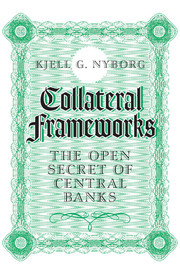Book contents
- Frontmatter
- Contents
- List of Figures
- List of Tables
- List of Exhibits
- List of Examples
- Preface
- Acknowledgments
- 1 Background and Motivation
- 2 Collateral Frameworks: Overview
- 3 Monetary Policy Implementation in the Euro Area over Time
- 4 Evidence on the Production and Usage of Collateral
- 5 Haircuts
- 6 Ratings and Guarantees
- 7 Market and Theoretical Prices
- 8 Collateral “Own Use”
- 9 Non-regulated Markets, Unsecured Bank Debt, and LTRO Uptake
- 10 Market Discipline
- 11 Bailing Out the Euro
- 12 The Endgame of the Euro Crisis
- 13 Restoring Credibility
- 14 The Problem with Collateral
- 15 Concluding Remarks
- Appendix: Haircut and Rating Rules Updates
- References
- Index
2 - Collateral Frameworks: Overview
Published online by Cambridge University Press: 06 January 2017
- Frontmatter
- Contents
- List of Figures
- List of Tables
- List of Exhibits
- List of Examples
- Preface
- Acknowledgments
- 1 Background and Motivation
- 2 Collateral Frameworks: Overview
- 3 Monetary Policy Implementation in the Euro Area over Time
- 4 Evidence on the Production and Usage of Collateral
- 5 Haircuts
- 6 Ratings and Guarantees
- 7 Market and Theoretical Prices
- 8 Collateral “Own Use”
- 9 Non-regulated Markets, Unsecured Bank Debt, and LTRO Uptake
- 10 Market Discipline
- 11 Bailing Out the Euro
- 12 The Endgame of the Euro Crisis
- 13 Restoring Credibility
- 14 The Problem with Collateral
- 15 Concluding Remarks
- Appendix: Haircut and Rating Rules Updates
- References
- Index
Summary
Central bank collateral frameworks are fundamental institutional features of the monetary and financial system that have gone largely unstudied by researchers, perhaps because they are simply taken for granted and seem of little consequence in times of “normalcy.” They are also often complex and opaque, requiring the studying of numerous legal documents to be accurately understood. Their basic function is to define the set of eligible collateral financial institutions can use in operations with central banks to obtain central bank money (liquidity). They also determine the quantity of liquidity that a central bank will supply for each eligible collateral, by, for example, setting haircuts in repos with eligible counterparties (“banks”). This places collateral frameworks at the core of the monetary system and the financial system that extends (from) it.
This chapter provides an overview of the role played by collateral frameworks and how they function in practice, with an emphasis on potential biases and distortions that may arise from their design. These issues are then investigated in subsequent chapters through a forensic-style analysis of the Eurosystem's collateral framework. The current chapter also previews the key findings of that investigation. A central characteristic of the Eurosystem's collateral framework is its broad eligibility criteria. The findings in this book are especially relevant with respect to understanding potential issues that arise in collateral frameworks sharing this characteristic. My general point is that collateral frameworks have potentially far-reaching effects on financial markets and the real economy. They are at the core of the monetary system and, as observed by Bagehot, “[m]oney is economical power.”
An important strand of the monetary economics literature focuses on the distinction between what economists call “inside and outside money” (Gurley and Shaw 1960). The former can be defined as “an asset representing, or backed by, any formof private credit that circulates as a medium of exchange,” with the latter being “money that is either of a fiat nature (unbacked) or backed by some asset that is not in zero net supply within the private sector of the economy” (Lagos 2006). According to Blanchard and Fischer (1989, chapter 4), “currency and bank reserves, high-powered money or the money base constitute outside money.”
Information
- Type
- Chapter
- Information
- Collateral FrameworksThe Open Secret of Central Banks, pp. 18 - 34Publisher: Cambridge University PressPrint publication year: 2016
